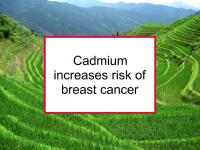Cadmium is a widespread and persistent heavy metal with no known beneficial effect on health. Cadmium accumulates in tissues since the body does not readily eliminate it. Exposure can occur both through food and non-food sources. The level of cadmium in urine reflects exposure to cadmium over the previous 20 to 30 years.
Breast cancer patients tend to have higher levels of cadmium in their breast tissue than cancer-free women. Cadmium is associated with increased breast density, a strong breast cancer risk factor. Cadmium functions as an endocrine disruptor, stimulating estrogen receptor (ER) activity and promoting uterine and mammary gland growth in mice. Numerous studies have demonstrated that cadmium promotes the growth and proliferation of breast cancer cells. Now a new meta-analysis of previous studies has reported a link between urinary cadmium levels and breast cancer risk. The same analysis did not find an association based on dietary cadmium intake.
Inconsistencies in cadmium study results
Cadmium exposure has been linked to increased risk of breast cancer in several population studies. For example, one study reported a dose-dependent relationship between urinary cadmium levels and breast cancer risk in Japanese women, a population that can accumulate significant cadmium levels through consumption of rice and seafood. However, not all epidemiological studies have reported an association. This could be because studies using food frequency questionnaires to assess dietary cadmium might not adequately estimate cadmium exposure over a period of decades. In addition, non-food cadmium exposures are not always estimated in such studies. Finally, some foods themselves counteract the harmful effects of cadmium, a factor that is difficult to take into account. Therefore, it is not surprising that studies assessing urinary or tissue cadmium levels produce more consistent results than studies attempting to measure dietary exposure.
Having said this, cadmium has been found to have anti-angiogenic properties that could partially offset its estrogenic actions in the progression of breast cancer. Cancer cells induce angiogenesis, the growth of new blood vessels, during the early stages of tumor development. This is necessary to provide the tumor with a blood supply that can enable it to grow beyond a very small size. In one study, ER+ breast cancer cells were exposed to subtoxic levels of cadmium and their angiogenic potential was assessed. Such cadmium exposure significantly inhibited angiogenisis. The authors concluded that cadmium might exert a bifurcated effect in breast cancer, promoting breast cancer development on the one hand and delaying tumor growth on the other.
Sources of cadmium exposure
Cadmium is easily absorbed through the lungs, less easily absorbed in the digestive tract, and difficult to absorb through the skin. Cigarette smoking and air pollution are common sources of cadmium exposure. Many plant-based foods, including some that are otherwise considered healthy, can contribute to cadmium exposure. However, some of these plants also contain compounds that tend to offset the deleterious effects of cadmium. Women can limit their cadmium exposure by avoiding regular consumption of a small group of foods that could significantly increase intake. Included are shellfish, canned fish, rice, flaxseed, escargot, sunflower seeds, and dried apricots from certain geographic regions. Consumers growing their own vegetables should avoid using roadside plots, which can be contaminated by cadmium from car exhaust. Please see our article on cadmium for more information.
Latest research reports urinary cadmium levels are linked to BC risk
The meta-analysis referenced at the beginning of this news story was designed to analyze and summarize the available data concerning the association between cadmium and breast cancer risk. To conduct the study, the authors obtained study data from relevant studies in the MEDLINE and PubMed databases; pooled data from six studies of dietary cadmium and five studies of urinary cadmium levels was analyzed.
Based on the authors' analysis, higher urinary cadmium levels were associated with increased risk of breast cancer (the highest quartile of urinary cadmium was associated with more than twice the risk of breast cancer as the lowest quartile) and risk increased with increasing urinary cadmium levels. However, the pooled data for dietary cadmium intake failed to find any significant association between dietary intake and risk of breast cancer. The authors conclude that cadmium exposure might lead to an increased risk of breast cancer, and urinary cadmium levels appear to serve as a reliable biomarker for long-term cadmium exposure and associated breast cancer risk.
